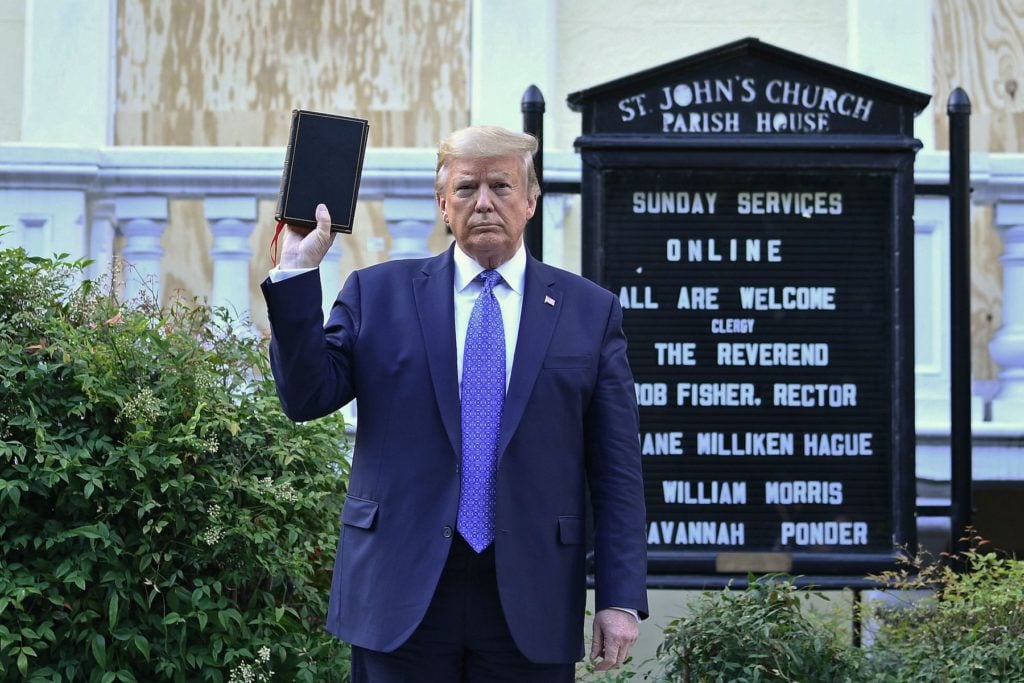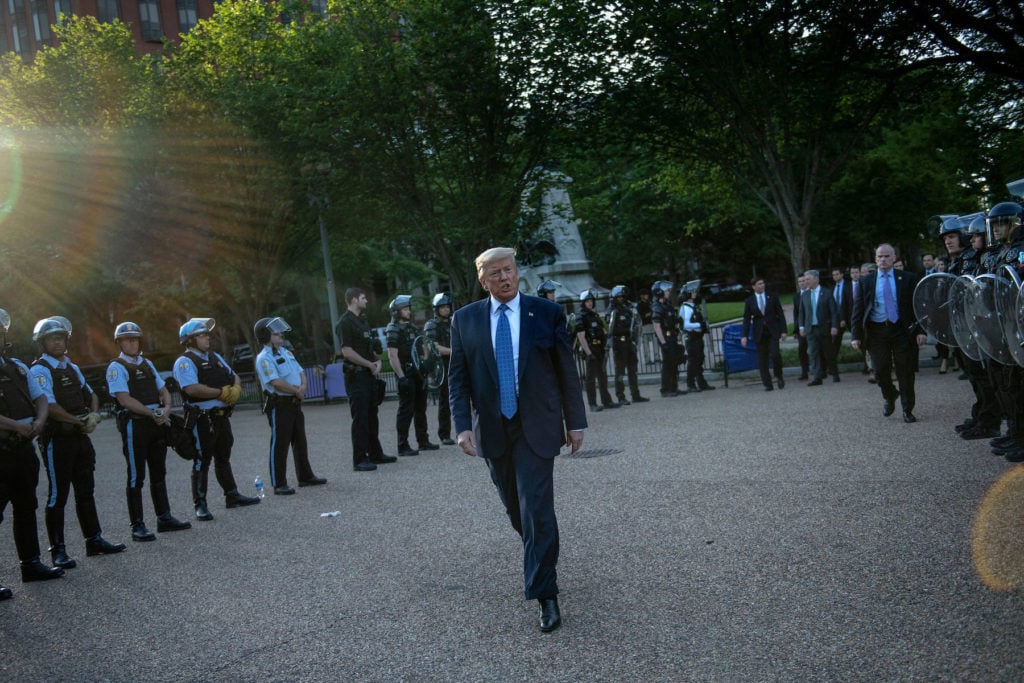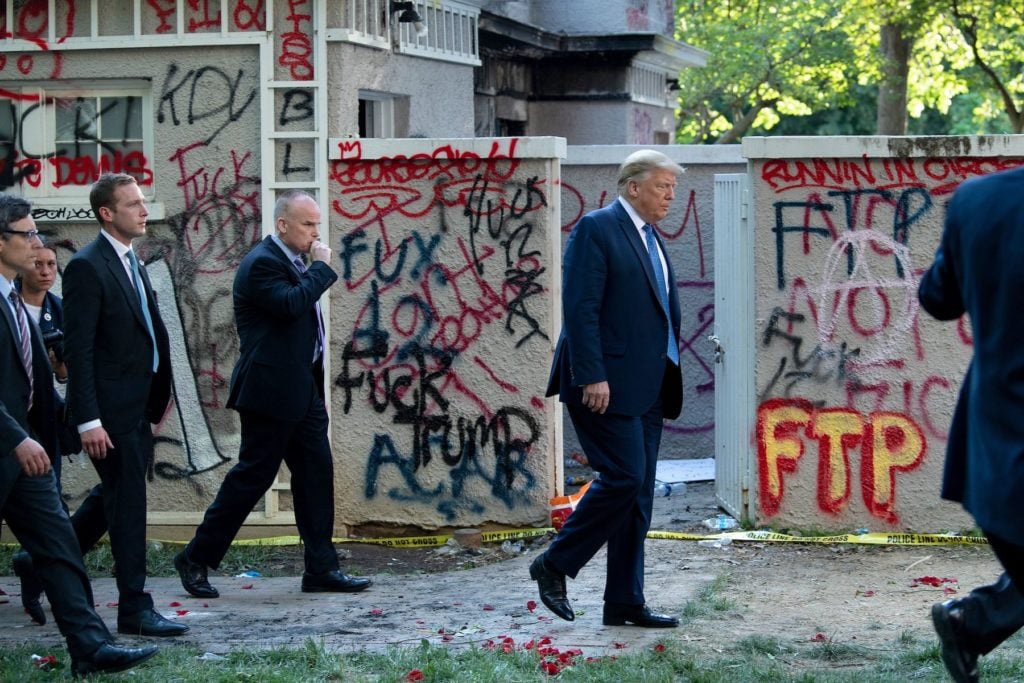Opinion
Trump’s Freakish Church Photo Op and the Widespread Arrests of Journalists Point to the Same Deeper Rot
The present media situation marks a shift in the state's balance between consent and force.

The present media situation marks a shift in the state's balance between consent and force.

Ben Davis

It’s worth drawing a bright line between two stories.
In an incident that may go down as one of the most grotesque of a grotesque presidency, Donald Trump on Monday night used police and the National Guard to clear the way for a personal photo op. Crowds of protesters were violently cleared from Lafayette Square in Washington, DC, with smoke grenades and pepper balls so that Trump could travel to nearby St. John’s Episcopal Church, the so-called “Church of Presidents,” which had been damaged by a basement fire during protests over the weekend.
There, Trump posed for photos with a Bible. Even without knowing how these images bracket out the surrounding scenes of repression, the resulting images have an off quality.
Watch the actual footage of the incident, if you haven’t. The whole thing that justified such an expenditure of force lasts a little more than two minutes. Trump doesn’t even open the Bible he clasps so awkwardly.
He speaks briefly and distractedly, clearly focused on the still image that this will become. He poses in front of the boarded-up church, first by himself, then with military leaders. Sirens are blaring nearby in the actual footage, evidence of the off-camera upheaval that the picture is meant to suggest he has under control.
Nothing about it makes sense as an event. It only makes sense from the point of view of politics reduced completely to decontextualized media events, to the raw assertion of an image of authority.

US President Donald Trump leaves the White House on foot to go to St John’s Episcopal church across Lafayette Park in Washington, DC on June 1, 2020. Photo by Brendan Smialowski/AFP via Getty Images.
In the New York Times’s long, thorough accounting of what led up to the disturbing photo op, there’s a clip embedded showing a cameraman covering the demonstration in the square just before it is cleared. You see a black-clad storm trooper surge forward, slam the cameraman with his riot shield bearing the word “POLICE,” then aggressively smash his camera down so that it can no longer film the incident. The police shove the reporter and his companion out of their position covering the action from a fence. Another officer beats them with a club across the back as they retreat. (According to reports, the cameraman worked for CNN.)
The fight over racist policing definitely isn’t just about Trump—though Trumpism can be seen as rising out of the racist backlash that came out of the initial surge of the Black Lives Matter movement in the late Obama years, which galvanized both the left and the right around this issue of policing. So I think it’s worth linking the attack on reporters for this law-and-order Bible photo op to the wider story of the systematic police attacks on journalists and photographers since the beginning of these immense new nationwide protests.
As of June 3, the US Press Freedom Tracker listed more than 233 “press freedom incidents”:
OUR LATEST DATA:
*233+ total press freedom incidents*41+ arrests/detainments
153 assaults (125 by police, 27 by others)
39 equipment/newsroom damageAssault category breakdown:
53 physical attacks (33 by police)
35 tear gassings
21 pepper sprayings
55 rubber bullet/projectiles— U.S. Press Freedom Tracker (@uspresstracker) June 3, 2020
These numbers do not convey the human stories behind these incidents, which have by now become a predictable feature of the unfolding crisis.
One of the most horrible is the case of Linda Tirado, a photographer and author of Hand to Mouth: Living in Bootstrap America. Tirado is based in Tennessee, but went to Minneapolis to cover the protests for George Floyd. She explains what happened to her in a vivid and disturbing essay for NBC news:
I was only on location in Minneapolis for two days. Thursday night I got into town around 8 p.m. and went out to take photos. I saw structure fires and smashed windows but the people I ran into were mostly just scared and angry and grieving, the property damage more a symptom than a cause. Friday night was the first night of curfew, and I started hearing that police were tear-gassing protesters before curfew had started, without issuing dispersal warnings.
I put on my goggles and respirator and ran into the gas. I was lining up a photo when I felt my face explode. My goggles came off and my face was suddenly burning and leaking liquid, the gas mixing with the blood. I threw up my arms and started screaming “Press, I’m press,” although I’m not sure if anyone could hear me with my breathing apparatus and the general chaos around me. Protesters took my hands and guided me to their medics, who put a bandage on my lacerated eye and drove me to the hospital.
Tirado underwent emergency surgery. She permanently lost use of her wounded eye.
She says she couldn’t tell if those who fired on her could hear her identify herself as press. But read enough of these accounts from state after state and it becomes clear that photographer after photographer does identify themselves, only to be targeted.
This is true of Adam Gray, chief photographer with the British press agency SWNS, arrested while documenting cops rushing in on crowds in Union Square on the weekend.
“I photographed the pandemonium that ensued of them pushing and grabbing protesters before one big cop came at me and pushed me to the ground with his truncheon to my chest,” Gray told Yahoo News UK. “I smashed into the floor with my three cameras as three or four cops then got on top of me, restraining me and putting me in handcuffs as I shouted repeatedly that I was press.”
The same pattern holds with Tom Aviles, a photographer with CBS Minnesota station WCCO-TV. He was hit by a rubber bullet and arrested while covering the intensifying protests Saturday night. Joan Gilbertson, the producer with him, says that a patrolman told her, “You’ve been warned, or the same thing will happen to you.”
"I'm not fighting": Tom Aviles, an award-winning photographer with CBS Minnesota, was arrested and struck by a rubber bullet while covering protests in Minneapolis https://t.co/sLIXA8qLaq pic.twitter.com/OU4LsYwSZq
— CBS News (@CBSNews) May 31, 2020
On Monday night in New Jersey, Asbury Park Press reporter Gustavo Martínez Contreras was livestreaming as police threw two teenagers to the ground. He was actually retreating when an officer shouted “fuck him, he’s the problem” and tackled Martinez Contreras to the ground.
He was wearing his official press badge.
The incident was so egregious that it has provoked an official apology from the state attorney general and will be the subject of an inquiry. “Once you see the video,” the head of the Asbury Park Press said, “the only conclusion you can come to is that another officer didn’t want anyone to film the arrest and took Gustavo down without asking questions.”
I was arrested during the protest against police brutality in Asbury Park earlier tonight. I was just released from the Belmar PD headquarters with a summons for failing to obey an order to disperse.
— Gustavo Martinez (@newsguz) June 2, 2020
This repeated pattern of attacks on photographers is part of the core dynamic of this new wave of protests.
Professional reporters are not the first to face the violent repressive force of the law. It was ordinary neighborhood residents in black communities, documenting acts of police violence with their smartphones, who transformed the wider public perception of the issue in the last decade. For some, like Ramsey Orta, the man who documented the killing of Eric Garner in Staten Island, their acts of witnessing have resulted in being relentlessly terrorized and harassed.
The line between journalist and ordinary citizen has become more and more blurred in the social media age. Every confrontation will now have numerous participants livestreaming and sharing images of the unfolding events as they happen.
A classical formulation in political theory states that in democratic societies, the powers-that-be rule by the combination of force and consent. It is the “consent” part that distinguishes them from openly dictatorial societies—leaders wield not just brute, repressive power but are able to win large enough blocs of the public to their side to maintain stability and isolate critics of the system. This is what Antonio Gramsci called “hegemony.”
In a deeply unequal and racist society, winning consent involves image-management, being able to shape the narrative—to tell the stories those in power want to tell and sideline the ones that are inconvenient.

US President Donald Trump walks back to the White House escorted by the Secret Service after appearing outside of St John’s Episcopal church across Lafayette Park in Washington, DC on June 1, 2020. Photo by Brendan Smialowski / AFP via Getty Images.
I wouldn’t say that the state’s powers of image management are completely undone. While an excitingly large section of the public now agrees that the system of policing is racist, dislikes the president’s law-and-order chest-beating, and supports this explosively radical wave of demonstrations, a majority is either concerned or mixed about the images of violent protests. This is definitely the pivot on which a hegemonic narrative of the need for a return to stability, while changing as little as possible, is going to turn.
While President Trump seems to be in a downward PR spiral, he can still count on a very loyal audience ensconced in a filter bubble amenable to his interpretation of reality. But the sheer emptiness of the St. John’s photo op shows that the effort to win a public relations battle outside of the hard core is minimal.
When I see these stories of professional photographers and journalists being brutalized by police, they seem to represent more than just mindless brutality, and definitely more than just accidents. They seem a symptom of the fact that the state’s ability to enforce its version of reality has already been eaten away. That has made it difficult to contain images that are radicalizing vast numbers of people. The flip side of this is that it leaves the state with less and less incentive to play nice with those documenting events. All that’s left is force.